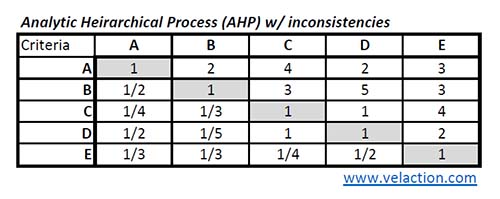Analytic Hierarchy Process (AHP)
The Analytic Hierarchy Process, or AHP, is a decision-making tool developed in the 1970’s by Thomas L. Saaty. Its key characteristics are that it breaks big decisions into smaller ones, and relies on direct, one-on-one comparisons to make judgments.

Essentially, the analytic hierarchy process breaks criteria into progressively smaller criteria, and then compares the criteria at each level in a head to head manner. This takes complex decisions and breaks them down into a series of small comparisons. The scoring of each head to head comparison provides the mathematical basis to assign a weight to that particular bottom-level factor. These factors are shown as a fraction of the decision, with all the factors adding up to 1.000.
The same rigor is applied to each option for each bottom-level criterion. Similarly, the tally for each decision is broken down so they add up to 1.000. When multiplied out by the weight of the factor, each option is assigned a global score. The tally of all the global scores for each option indicates the best choice.
Note that this can be an extremely time-consuming process as the number of criteria and options rises. There is an exponentially rising number of comparisons as criteria and options are added. For example, when comparing options A, B, and C, you would need direct comparisons for A-B, A-C, and B-C. If you add in a D, you then need to compare A-B, A-C, A-D, B-C, B-D, C-D. Note that adding one option required 3 additional comparisons.

There is a measure called the consistency ratio that is used to make sure your comparisons make sense. It basically checks the transitive property of logic.

Sample Analytical Heirachy Process (AHP) with inconsistencies
In the example, criteria “A” is viewed as twice as important as criteria “B”, and B is 3 times as important as criteria “C”. Logic says that “A” would be 6 times the importance of “C”. In this example, when “A” and “C” went head to head, it was listed as only 4 times as important. There is inconsistent logic there.
As you can imagine, it can be difficult to keep track of these transitive properties when the decision gets big with lots of criteria.
With complicated decisions, it can be a good idea to use an AHP tool to help manage the decision-making process. It can calculate the consistency ratio for you, and some can even limit inconsistent entries.


0 Comments